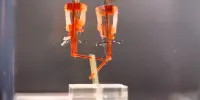Damian Havelock has more experience with blast furnaces than most individuals in Teesside.
Damian entered the iron and steel sector at the age of 18 in 1985, and he remained employed there until the Redcar Blast Furnace closed in 2015.
His career was created in the fire as a Day Laborer on the Bessemer Blast Furnaces at Cleveland Iron, where he was born in Normanby and attended school. Before relocating to the Continuous Casting Plant until iron and steelmaking were put on hold in 2010, he worked there for eight years.
After that, he worked as an energy distribution controller for Redcar Power Station for two years. When optimism was restored in 2012, he joined the Redcar Blast Furnace as a Production Manager and stayed there till the factory shut down three years later. He cherishes the memories of the hope that surrounded this fresh start.
“Nobody envisaged this happening when the plant was first mothballed,” said Damian.
“This relaunch made it possible for many new and youthful people to enter the sector. To observe them grow, to observe the looks on their faces as they caught glimpses of the processes with their immense amounts of molten material, enormously large and powerful gear, loud noises that I’m sure first startled most, and the smells of sulfur, gas, slag, and many other products That was satisfying and unforgettable.
Damian described the final blowdown of the blast furnace in 2015 as his career’s pinnacle achievement, albeit being a sorrowful occasion.
Due to its complexity, risk, and resource requirements, the kind of operation Damian was in charge of seven years ago was often planned out months in advance. Just 36 hours’ notice was provided to the small RBF team to begin.
But despite the overwhelming difficulty, they succeeded in safely lowering the blast furnace to “Tuyere level.”
A tuyere is an in-furnace blasting nozzle. The blast furnace was always in use; it wasn’t turned off unless a reline was necessary.
The furnace would be put out of commission during this procedure, and a special hole known as a salamander tap would be drilled to remove the final drop of liquid iron from the furnace hearth.
But in 2015, the Redcar Blast Furnace never had a salamander tap installed, and as a result, a sizable solid lump of iron is currently sitting at the furnace’s base. The lowest temperature a furnace can be set to without drilling a salamander tap is the Tuyere level.
“The most disappointing time for me in the industry was when I realized that the people who had joined us only three years earlier would not get the opportunity to have an extended career within such an exciting and fulfilling workplace — with people who genuinely cared both for each other and the future of steelmaking on Teesside,” Damian continued.
Damian, 56, is now a significant player in the revitalization of Teesworks’ historic steelworks. In the South Tees Site Company’s decommissioning activities and work to create and maintain the steelworks site’s safety, he has taken the reins.
He reflected on his transition to the Blast Furnace and said that it was “enormous” in comparison to the ones he had previously worked on and had a lot more automation.
The product, according to Damian, was fantastic since it was so different from what he was used to.
The technical department we had at the blast furnace, with Peter Warren and the staff, was amazing. It was more specialized from a technology standpoint. We had to deal with low-quality ores and coals because of the difficulties SSI was having, and there were occasions when it was challenging to deliver raw materials to the furnace due to a scarcity of them.
“They added the 2013-commissioned PCI plant to all of that mixture.
When dealing with low-grade ores and the challenges of getting them, operating a PCI can be challenging. Pete Warren and the technical crew stepped in at that point and did a fantastic job.
We were producing the second-cheapest iron in Europe just a few weeks before we really destroyed the furnace.
Finally, tragedy struck in 2015. He acknowledged that the conclusion was a severe gut punch.
“They spent a lot of money on the blast furnace,” Damian said, “relining it and installing a new computerized system that handled the procedures.
“Unfortunately, they didn’t spend so much money on our customer, the steel company, as well as the plants that fed the blast furnace. Due to the fact that we weren’t receiving ores or coke, we were constantly at their whim.
“They weren’t good when we were there. We were producing the required quantity of iron, but since the steel plant was experiencing problems, we had to lower our output to keep up with it.
“I believe we would be in a different situation if the investment had been made in all other plants, as it was on the blast furnace.”
As 2015 progressed, uncertainty abounded, and Damian claimed to be aware of impending financial storm clouds.
Damian said, “We were finding it difficult to obtain raw materials due to the financial situation; we had been aware of it for some time.
Even though we were aware of our predicament, it still came as a bit of a shock when it suddenly stopped happening every month.
For Damian, recollections of sadness and what might have been were all-pervasive.
“I look around the UK, and we have two integrated steel factories,” he continued. I think that starting in the 1990s, Teesside was neglected in terms of investment.
“I believe Teesside might still be the premier integrated steel factory in the UK if the investment had been made in Teesside as it was at the others.”
The CPO process that followed and the manner in which the Blast Furnace was shut down made it more difficult to maintain the site’s safety.
Damian said, “I don’t think people understand it, even individuals who used to work here.
“From the outside looking in, people may not understand the effort that has been done over the past seven years.”
Damian still keeps in touch with pals from 1985 and has ties to all the plants he worked on in terms of friends and coworkers.
He was adamant that the challenging workplaces made people closer.
When you first stand on the cast house of a blast furnace and witness molten stuff streaming beneath your feet with gas, slag, and sulphur everywhere, it is an eye-opener, the man continued, “I started as a young man.
“Despite being young, you gradually realize how dangerous that was. That, in my opinion, pulls people together. Everyone is aware that their back is being watched, and you are watching everyone else’s back.
“Due to the nature of the plant and the operation you’re doing, that has to happen.
That explains why coworkers get along so well. All the plants I’ve worked on have had great camaraderie.
The bp-led Net Zero Teesside project will now use the Redcar Blast Furnace site and surrounding area.
The £1.5 billion project will be the first fully integrated gas-fired power and carbon capture, utilization, and storage (CCUS) project in the UK. It is being carried out by a group of industrial, power, and hydrogen enterprises. The combined cycle gas turbine electricity station owned by NZT Supply will generate enough electricity annually to power up to 1.3 million homes.
The program, which hopes to be operational within the next five years, has the potential to add £450 million to the economy annually and 5,500 direct jobs.
While Teesside’s steel industry will come to an end with the destruction, Damian is optimistic about the future.
He declared: “The new industries are cleaner; carbon capture and storage is a wonderful idea. I don’t want to go too far back in time, but when we were still producing iron and steel, CCUS was going to come to this location.
If we could have connected with CCUS and been the first net zero steelmaker, that would have been a terrific thing. I’m looking forward to Net Zero Teesside even though it won’t materialize.
We also have SeAH Wind, which is located at South Bank Wharf and offers a cleaner working environment.
Damian thinks individuals on the new sites are losing out on something, despite the fact that it was occasionally dangerous and filthy.
Anyone who hasn’t had the opportunity to work in this field has missed out, he remarked.
“I genuinely think that. However, I suppose it will benefit their health more.













